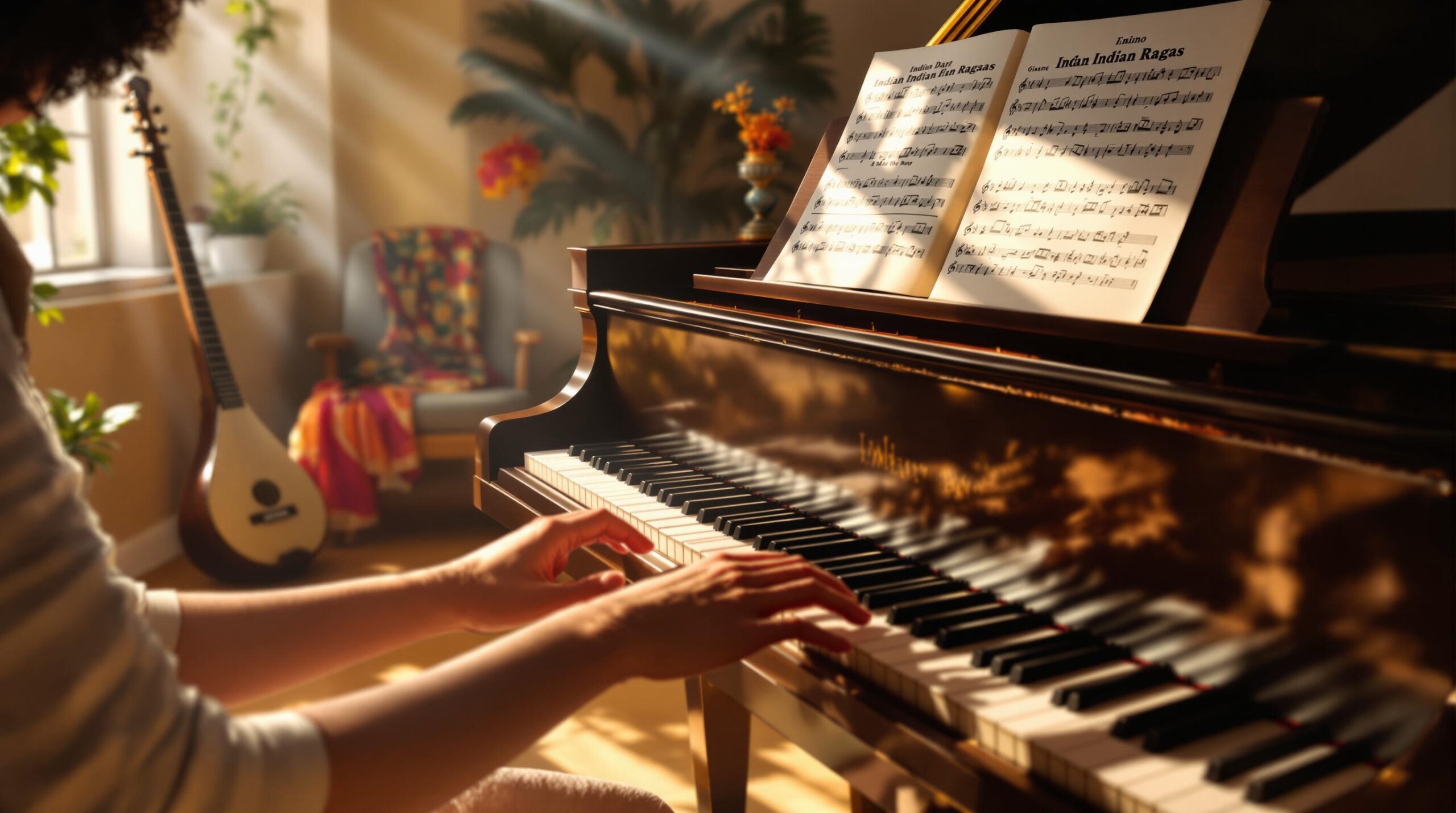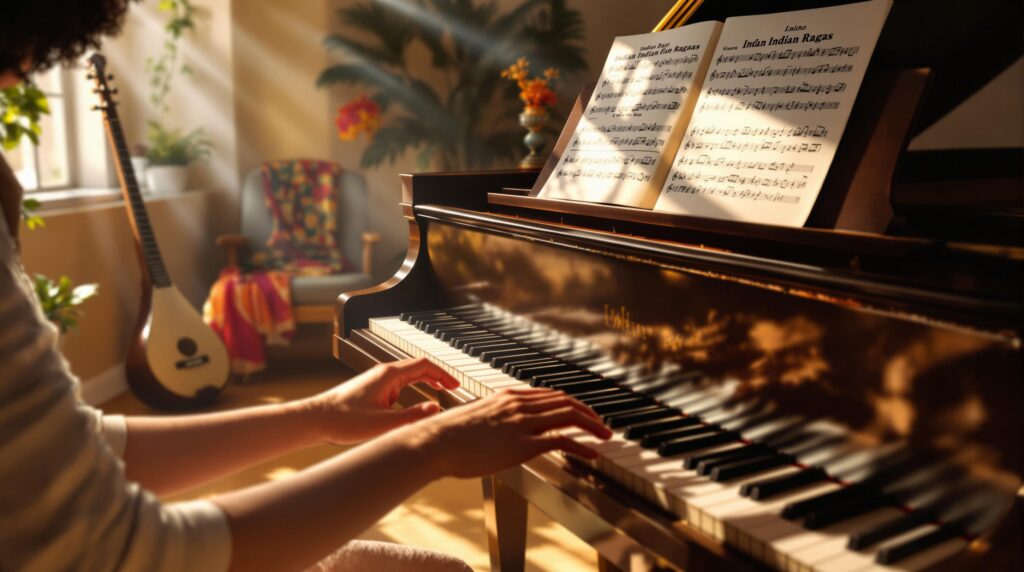
Indian ragas bring a unique flavor to piano playing, combining age-old musical traditions with the piano’s expressive potential. Here’s what you’ll learn in this guide:
- What are Ragas?: Ragas are more than scales; they are frameworks of notes designed to evoke specific emotions.
- How to Play Ragas on Piano: Focus on ascending (Aroha) and descending (Avaroha) note patterns, key notes (Vadi and Samvadi), and adapting Indian ornamentation techniques like glides (Meend) and oscillations (Gamak).
- Beginner-Friendly Ragas: Start with Raga Yaman (C D E F# G A B C) and Raga Bhupali (C D E G A C).
- Rhythm Integration: Learn tala (Indian rhythmic cycles), starting with Teental (16 beats), to add depth and structure.
- Practice Tips: Dedicate time to scales, rhythmic exercises, and characteristic phrases while emphasizing key notes for authentic raga expression.
This guide bridges Indian classical music with piano techniques, offering step-by-step instructions for beginners. Whether you’re new to ragas or experienced in piano, this is your starting point to explore these rich musical traditions.
Learn how to play Indian Classical Music on Piano
Raga Building Blocks
Playing ragas on the piano starts with understanding their basic elements and how they can be adapted to the keyboard. While traditional ragas include microtones not available on the piano, their essence can still be conveyed by focusing on specific note patterns and relationships.
Up and Down Patterns
A raga’s identity is rooted in its ascending (Aroha) and descending (Avaroha) sequences. These patterns are key to interpreting a raga on the piano:
- Aroha: Play the ascending sequence with care, highlighting how each note connects to the next. Begin with the root note (Sa) and follow the specific pattern for the raga.
- Avaroha: The descending sequence often includes additional notes or subtle variations. Use the sustain pedal lightly to allow notes to blend, creating a smoother, flowing sound.
For instance, in the Yaman scale:
- Aroha: Sa Re Ga Ma# Pa Dha Ni Sa
- Avaroha: Sa Ni Dha Pa Ma# Ga Re Sa
Once you’re comfortable with these patterns, turn your attention to the key notes that shape the raga’s character.
Key Notes
Each raga is defined by two key notes:
- Vadi: The dominant note, which should stand out through repetition or longer emphasis.
- Samvadi: The second most important note, often spaced a fourth or fifth interval from the Vadi.
When practicing on the piano, give these notes special attention by:
- Holding them longer
- Adding slight dynamic changes
- Returning to them often during improvisation
Beginner-Friendly Ragas
If you’re new to ragas, these two are great starting points for piano practice:
-
Raga Yaman
- Scale: C D E F# G A B C
- Vadi: Pa (G)
- Samvadi: Sa (C)
- Traditionally played in the evening, it has a smooth and uplifting feel.
-
Raga Bhupali
- Scale: C D E G A C
- Vadi: Ga (E)
- Samvadi: Dha (A)
- Its simple pentatonic structure makes it ideal for beginners to explore and enjoy.
Piano Techniques for Ragas
Moving beyond basic note patterns, specific techniques bring out a raga’s unique character on the piano.
Note Decorations
Recreating the signature ornaments of Indian classical music on the piano involves some creative approaches:
- Meend (Glide):
- Use the sustain pedal lightly to create a smooth effect.
- Add quick grace notes between the main notes.
- Adjust dynamics to mimic the natural flow of a glide.
- Gamak (Oscillation):
- Rapidly alternate between neighboring notes.
- Play controlled trills to emulate oscillations.
- Repeat notes with subtle changes in dynamics for added depth.
Finger Positions
Mastering finger placement is essential for smooth and expressive playing:
- Root Position: Place your thumb (1) on Sa, the root note of the raga.
- Scale Movement: Follow the standard finger pattern for major scales:
- Right hand ascending: 1-2-3-1-2-3-4-5
- Left hand descending: 5-4-3-2-1-3-2-1
Practice crossing your thumb efficiently to ensure seamless transitions during faster passages.
Practice Methods
1. Scale Familiarization
Dedicate 10–15 minutes to slow scale practice, focusing on both ascending and descending patterns. Use a metronome at 60 BPM, playing one note per beat, to develop precision and comfort.
2. Rhythmic Integration
Experiment with different rhythmic patterns, such as quarter notes, eighth notes, and triplets, to enhance your timing and versatility.
3. Phrase Development
Start with short, 4-note phrases, then gradually build longer sequences. Record your practice sessions to evaluate tone and rhythm consistency. Pay extra attention to the Vadi and Samvadi notes, emphasizing them slightly to highlight their importance in the raga.
These techniques will help you achieve greater control and expression in your raga interpretations on the piano.
sbb-itb-b8bc1ab
Rhythm in Indian Music
Once you’ve mastered the basics of note techniques, incorporating rhythm can add depth to your raga expressions. In Indian classical music, rhythm, or tala, plays a crucial role in shaping and enriching raga performances, even on the piano.
Tala Basics
The rhythmic structure of tala complements the melodic patterns of a raga, providing a framework for improvisation. Tala consists of repeating rhythmic cycles with a fixed number of beats. These cycles are divided into smaller sections called vibhags. The first beat of each cycle, known as sam, acts as the anchor point and is heavily emphasized.
Key elements of tala include:
- Matra: The individual beats within the cycle.
- Vibhag: Groups of beats, similar to measures in Western music.
- Sam: The first and most accented beat of the cycle.
- Khali: Beats marked by a hand wave, indicating an "empty" or less emphasized moment.
Beginner Tala Patterns
One of the most commonly used tala patterns in North Indian classical music is Teental. It consists of 16 beats divided into four equal sections:
| Vibhag | Beats | Count | Hand Gesture |
|---|---|---|---|
| 1 | 1-4 | Dha | Clap |
| 2 | 5-8 | Dhin | Wave |
| 3 | 9-12 | Dhin | Clap |
| 4 | 13-16 | Dha | Wave |
To start, practice counting these beats while playing simple scales on the piano. Begin at a tempo of 60 BPM and gradually increase the speed as you become more comfortable.
Combining Ragas with Rhythm
To blend melodic phrases with tala, keep these tips in mind:
- Start Simple: Use short melodic phrases that align with the sam (first beat of the cycle).
- Accentuate Key Beats: Highlight important notes on significant beats like sam and khali.
- Build Repetitions: Develop repeating melodic patterns that fit seamlessly within the tala structure.
For practice, tap out the tala pattern with your left hand while playing melodic phrases with your right. Using a metronome set to accent the first beat of each vibhag can help you stay aligned with the rhythm. This approach will also improve your ability to maintain independence between your hands.
First Steps in Raga Playing
Now that you’ve got the rhythmic framework down, it’s time to dive into your first raga. We’ll begin with Raga Yaman, a cornerstone of Indian classical music that’s perfect for beginners.
Learning Raga Yaman
The defining feature of Yaman is the raised Ma (Ma#), which gives it its distinctive sound. Start by practicing the ascending and descending patterns at a steady 60 BPM, focusing on smooth and accurate transitions. Once you’re comfortable, move on to exercises designed to refine your technique.
Yaman Practice Guide
To master Yaman, use these focused exercises to get a feel for its unique qualities:
-
Basic Scale Practice
Work on ascending and descending the scale at a slow pace. Gradually pick up speed as you gain confidence. -
Characteristic Phrases
Familiarize yourself with these key patterns:- Re Ga Ma# Pa
- Ni Dha Pa Ma#
- Ga Ma# Dha Ni
-
Pattern Integration
Combine these phrases with the Teental rhythm. Start at a slow tempo, then gradually increase speed. As you progress, introduce more complexity to challenge yourself.
Learning Materials
To deepen your practice and understanding of Yaman, explore these resources:
- Basic Exercises: Focus on note patterns and finger placement.
- Rhythm Workbook: Learn how to integrate Yaman with different talas.
- Advanced Studies: Experiment with melodic variations to expand your skills.
For more structured learning, Cooper Piano offers lessons that incorporate these concepts into personalized piano instruction.
Next Steps
Main Points Review
Mastering a raga requires accuracy in scales, precise ornamentation of notes, and consistent rhythmic patterns. Pay close attention to perfecting melodic ascents and descents while keeping a steady tempo. These fundamentals are crucial before tackling more intricate techniques.
Moving Forward
To advance your raga practice, try the following:
- Add dynamic shifts to bring more emotion to your performance
- Record your sessions to pinpoint areas that need improvement
- Dedicate at least 30 minutes daily to practice, focusing on stamina and refining advanced skills
Cooper Piano Services
Expert guidance becomes increasingly important as you improve. Cooper Piano provides specialized piano lessons designed to enhance your understanding and technique in Indian classical music. Their instructors offer:
- Tailored guidance on interpreting ragas
- Technical exercises specific to Indian classical styles
- Constructive feedback to refine your practice and progress
Additionally, their professional tuning services ensure your piano stays in top condition. This allows you to concentrate fully on developing the precise tonal control essential for expressive raga performances.

